Magic: the Gathering (MTG) has no doubt become a highly complex game, thanks to 30 years of game development and rule changes. Even for long-time players, certain rules are still not as well understood, resulting in misplays or overlooked effects.
We highlight 10 MTG rule misunderstandings that almost all players would have encountered at one point or another. Some might surprise you!
(Update!) Many players have commented that the Rule of Law bit is wrong – and you guys are right! We apologise for the error, MTG rules are tricky and we are constantly learning new things. For the benefit of context, we will strikethrough the text just so that others can still refer to it if needed. There has also been some feedback about the point regarding Suspend cards and its Mana Value. Likewise, will update on that soon!
If there are any other MTG rules that you feel are often misunderstood and should be on this list, do share it in the comments.
Protection from a Colour Does Not Prevent Destruction from Board Wipes
Protection is an amazing ability that gives 4 different kinds of benefits – Damage prevention, Enchantment Aura removal, Blocking, and Targeting (DEBT in short). What is doesn’t do is prevent “destroy” effects. The misunderstanding arises when cards such as Go for the Throat has the Destroy effect, but is actually unable to target a Creature with Protection since “targeting” is part of DEBT.
Then there are cards such as Wrath of God, which also includes the Destroy effect but does not target specifically. In these scenarios, Protection from white will not save a Creature from Wrath of God. Wrath doesn’t target, and as clarified above, Protection doesn’t save a Creature from direct “destroy” effects.
Mana Abilities Do Not Use the Stack
Although a Mana Ability is considered an Activated Ability, it is exempted from using the Stack simply because it generates Mana. This rule was likely made so that players can’t counter the fundamentals of playing MTG. Without Mana, nothing can be done. Hence by having Mana abilities be free from the Stack, opponents cannot respond. Read more through the link below if you want to understand more about the differences between abilities.
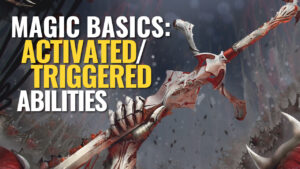
Dual-Faced Cards Enter the Battlefield Front Face Up if ‘Blinked’
Blinking is an unofficial term whereby an effects causes a Permanent to leave and then reenter the Battlefield. Whenever you “blink” any dual-faced card, it always reenters the Battlefield with its front face up, even if the card was originally back face up. That means, casting Ephemerate on your Ulvenwald Behemoth will result in the card entering as the front side Ulvenwald Oddity. It’s still a threat, but a smaller one and could save you for a turn to find an answer. Many players forget to take advantage of this rule, since there are many cards that can easily blink a threat away.
Damage is no Longer Put on the Stack
Once upon a time, damage resolution was a trigger that was placed on the Stack. What that meant was that a Creature could deals its combat damage and still be able to interact with its own abilities or it controller’s spells. This created too much value as there was no downside to letting your Creature deal combat damage.
Today, damage resolution happens immediately with no more opportunities for players to respond once everyone has passed Priority.
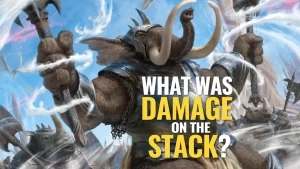
Players No Longer Take Damage from Unspent Mana
As a precious resource, Mana was something that Wizards of the Coast didn’t want players taking lightly. If you had generated 2 Mana but only spent 1, the remaining 1 Mana would ‘burn’ you, effectively taking 1 damage. This “Mana Burn” rule was so incidental that it didn’t matter for the majority of games.
Today there are more and more combos that can generate infinite Mana. But unless you’re running Creatures like Yurlok of Scorch Trash (what a name!), none of that is going to harm you.
+1/+1 and -1/-1 Counters Cancel Out Each Other
While you’ll see +1/+1 counters a lot more than -1/-1s (simply because the latter is usually applied for the Infect mechanic), many players don’t realise that +1/+1 counters and -1/-1 counters don’t coexist on a Creature, or any other Permanent.
The +1/+1 and -1/-1 counters actually cancel out each other and are removed immediately when “State Based Actions” are checked (e.g. right after the resolution of a spell). So if you had 5 +1/+1 counters on a Creature, and 3 -1/-1 counters are added, you’ll only be left with 2 +1/+1 counters. This can become important as some spells such as Heartless Act remove counters, and you might think to just remove the 3 -1/-1 counters, but unfortunately by the time you attempt to cast that spell, the counters are no longer there.
There is no Priority for Either Player During the Untap Phase
Unlike every other Phase, the Untap Phase happens right away once a player ends his/her turn. There is no pause (Priority) for either player before the active one gets to untap his/her Permanents. Likewise, there is no pause at the end of the Untap Phase either. The untapping happens in a snap, and before you know it, it’s the beginning of the Upkeep Phase before Priority kicks in.
Players will quickly get the hang of this rule the more they play. Just bear in mind that if you were thinking of casting any spells or activating any abilities, it should be done at the opponent’s End Step. You’ll only be disappointed if you attempt to do the same during your Untap Phase, because that is no chance to do so.
Cards with Suspend Have a Null Mana Value / Casting Cost
The Suspend mechanic has seen its fair share of play in Profane Tutor or Ancestral Vision, but it certainly is complicated. What many players overlook or misunderstand is that certain Suspend cards have a special “null” Mana Value. There is no Mana cost or symbol in the top right of the card. It’s not 0, it simply does not have a Mana Value at all.
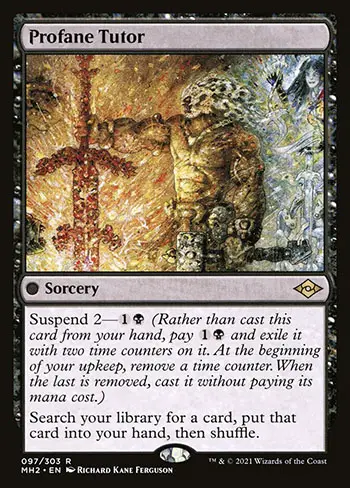
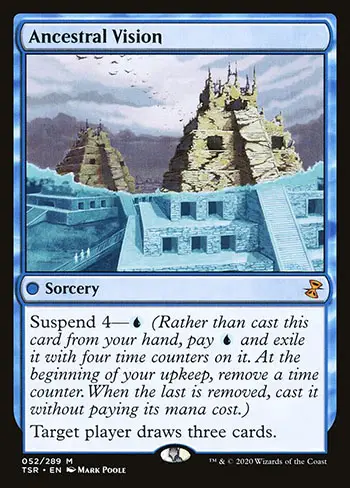
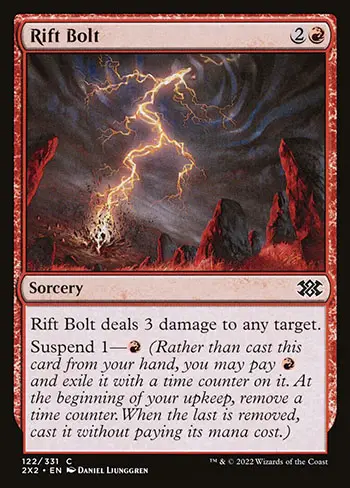
This is important because when there is an effect that says, for example, “you may cast that card if it has Mana Value X or less,” even if X is 1000, you simply can’t cast Profane Tutor because there is no Mana Value to look at. The same rule applies for any other effects that take Mana Value into consideration. Not all Suspend cards have a Null Mana Value though – Rift Bolt has a regular casting cost as well and thus has a MV of 3.
The Aftermath (Right) Side of Split Cards Can Only be Cast From the Graveyard
Split cards give you two different effects into a single card, though cast separately. Most time you are able to cast either half depending on what suits your game state. However, in the expansion set Amonkhet, a new Aftermath mechanic was introduced to Split Cards. Mostly found on the right side of the card, Aftermath spells can only be played from the Graveyard.

In Reduce//Rubble, Rubble cannot be cast from your hand nor from Exile. So if you use Mizzix’s Mastery and target Reduce//Rubble, you can only cast the Reduce (non-Aftermath) side of the card. This is because the card is now in Exile, and the Aftermath Rubble can only be cast from the Graveyard.
Rule of Law Effects Last The Turn Even After Destroyed
Thanks everyone for the feedback! This has since been proven to be incorrect. We will just leave the cancelled text as context for anyone reading the comments.
In Commander, stax pieces such as Rule of Law and Archon of Emeria are common sights. What players often get wrong about these “one-spell-a-turn” rule is that they assume that using one spell to destroy that card then lets them cast more in that same turn.


In truth, once the player has started the turn with a Rule of Law or similar effect in place, that restriction will last the entire turn. Thus using a Disenchant to destroy Rule of Law on your own turn doesn’t let you cast more spells again. It feels counter intuitive, and thus is one of the most misunderstood rules in MTG.
End Step
Is your brain a little fried by now? At the very least, we hope this has been an eye opener, and that you now have a better understanding of how complicated MTG can get. The next time any of these scenarios pop up at the game table, use the info here as a handy reference.
Are there any other tricky rules that have surprised you? Let us know in the comments!





Scenario 10 is incorrect. Rule of Law creates a Continuous Effect that ceases to exist if the card leaves the battlefield. If Rule of Law is NOT on the battlefield, then there is no restriction on how many spells a player may cast that turn, even if RoL was on the battlefield at the beginning of the turn. If Rule of Law IS on the battlefield, any player who has cast one or more spells that turn cannot cast any more spells, regardless of when RoL entered play.
The case you may have been trying to expound on is whether a player may play another spell after a Rule of Law has resolved that turn, which they cannot so long as RoL is on the field.
In the case put forward in the article, if a player casts Disenchant and destroys Rule of Law, no player is restricted to casting only one spell that turn unless specified by another effect currently in play.
TLDR: So long as it is on the battlefield, Rule of Law checks the ENTIRE turn to see if a player has already cast a spell, regardless of when Rule of Law entered the battlefield. If Rule of Law leaves the battlefield, its effect no longer applies.
Your wrong about “null” cards and rule of law.
Judge! Suspend cards do have a mana value of zero, try for instance electrodomince on mtgo or arena, maybe try reading the rules before publishing factually inaccurate articles
Ted is wrong about suspend cards not being able to be cast when a card’s effects say “you may cast that card if it has Mana Value X or less“. That’s kinda the idea for how all the cascade deck types work, ala Living End or Glimpse of Tomorrow. It’s also why Electrodominance and As Foretold are able to cast spells like Ancestral Recall and Profane Tutor.
Ted is also wrong about his entry concerning Rule of Law and Archon of Emeria. If the permanent providing the continuous effect leaves the battlefield, then the continuous effect stops….effecting. Might want to look into comprehensive rule 611 that covers continuous effects.
Seems that whoever hit publish on this piece doesn’t really know much about the game, or at least enough about it to have any proofreading/editing responsibilities.
Sorry to point this out, but you are very wrong about the effect of Rule of Law. It is a static ability with a continuous effect. And once it leaves the battlefield, its restriction is removed.
Rule of Law’s effect dosent use the stack. It dosent put a limit on every single turn at the beginning of the turn, but rather, had a continuous ability that checks how many spells you cast this turn, and if you already casr a soell you cannot cast another.
And again, the restriction is lifted once the card is removed.
You are incorrect about “Rule of Law”. Once removed, that static effect ends. Any player can absolutely destroy Rule of Law, and then cast more spells afterwards.
Hey your wrong about the rule of law.
Might want to do another proof read. You said in the section on +1/+1 counters that “So if you had 5 +1/+1 counters on a Creature, and 3 -1/-1 counters are added, you’ll only be left with 2 -1/-1 counters.” You would in fact have two +1/+1 left on the creature not -1/-1 counters.
I did not in fact know that rule of law like effects last until end of turn if you started the turn with it and then destroyed it.
Thanks for the article! Most of these are really helpful for newer players although I believe you are wrong about two of these. Firstly the one about suspend cards that don’t have a Mana cost; rule 202.3 states in part “the mana value of an object with no mana cost is 0″. In terms of the ability to cast such spells rule 118.6 states ” Some objects have no mana cost. This represents an unpayable cost. An ability can also have an unpayable cost if its cost is based on the mana cost of an object with no mana cost. Attempting to cast a spell or activate an ability that has an unpayable cost is a legal action. However, attempting to
pay an unpayable cost is an illegal action.” And further clarifies in 118.6a “If an unpayable cost is increased by an effect or an additional cost is imposed, the cost is still
unpayable. If an alternative cost is applied to an unpayable cost, including an effect that allows a player to cast a spell without paying its mana cost, the alternative cost may be paid.” Meaning that such spells can still be cast by effects that allow you to cast a spell without paying its mana cost and the game sees these object as having a mana value of 0 not as not having a mana value at all as you stated. Second is the effects from rule of law type cards; the abilities of these cards are static abilities and rule 604.2 states “Static abilities create continuous effects, some of which are prevention effects or replacement effects. These effects are active as long as the permanent with the ability remains on the battlefield and has the ability, or as long as the object with the ability remains in the appropriate zone, as described in rule 113.6.” This means that their effects only apply while the object is on the battlefield. The rule you linked to is only referring to your ability to cast additional spells the same turn that these cards enter the battlefield, not when they leave the battlefield. This means that if someone casts a spell on your turn then you cast rule of law the effect will prevent them from casting any more spells on your turn because the effect sees that they’ve already cast a spell this turn, if the permanent is removed later in the turn though, it frees them up to cast more spells on your turn if they wish since the static ability isn’t applying any more. If the intent of the card is to last until end of turn even after being removed, it will state this such as on the card “titania’s song”. Hope this helps 🙂
Ted needs to double check the neural net that generated this list for him, 8 and 10 are patently wrong.
All spells have a mana value. Profane Tutor and Ancestral Vision have a mana value of 0, not “null”. Decks in Modern use spells with Cascade to cast cards with Suspend, like Living End and Crashing Footfalls.
Rule of Law is a permanent that generates a static effect. It only applies until the disenchant used on it removes it from the battlefield. “That restriction will last the entire turn” is entirely not how this works.
Your point about rule of law is not correct.
If you disenchant a rule of law and it is no longer on the battlefield, there is nothing preventing you from casting more spells.
However, if you cast rule of law during your turn, you can’t cast another spell after that. The official card lookup site, Gatherer, says as much.
Hi, the last one about rule of law effects not ending immediately after the card with the static effect leaves the battlefield is wrong. If you destroy bounce or exile the card the effect ends immediately and you can play spells as normal. Would love to see your source on that because hopefully we can get false information like that down so as to not confuse newer players.
Rule of Law style cards absolutely stop working if destroyed. All of those cards have a static ability that only works while in play, the game has no functionality to “remember” that that effect would still apply.
Also, cards like Profane Tutor and Ancestral Vision can absolutely be cast with effects that say “cast a spell that costs x or less”, because they are treated as having a mana cost of zero. The thing you can’t do is cast them through effects that give them alternate costs equal to their mana cost, like Snapcaster Mage, because they don’t have one.
This article needs to be fact checked.
Your rule of law ruling is incorrect. The ability is a continuous ability generated by a static effect. If the static effect leaves the battlefield, the effect will cease to exist unless the card granting the continuous affect specifies a duration or says it lasts until the end of turn specifically.
Thus, if rule of law or archon is removed from the battlefield players may cast spells normally.
https://www.mtgsalvation.com/forums/magic-fundamentals/magic-rulings/814721-rule-of-law-rulings
Both the mana value and rule of law ones are incorrect.
A card such as living end or crashing footfalls has no mana cost, however their mana value is still 0. While you cannot normally cast them and they won’t grow your embodiment of agonies, you can cascade into them or cast them via an Electrodominance with X = 0. There are multiple modern decks built around cascading into cards like these.
Rule of Law can look back in time to see whether you cast any spells before it enters the battlefield on the turn you play it (as started in the rulings on it), but once it dies the ability is no longer active (611.3b and 113.6 both address this.)
I would add that people often forget to order blockers when multiple blockers are declared and don’t realize that morph is a special action rather than a triggered ability and therefore doesn’t use the stack and can’t be responded to (although anything that triggers when a card is turned face up can be).
Ref: #10.
Abilities like that on “Rule of Law” and the corresponding ability on “Archon of Emeria” are “static effects” which are only in effect as long as the card which produces that effect is in play (Core Rules 611.3b). Once you remove the care, that static ability is not longer around to stop anyone from casting more than one spell.
It would be different if the card is worded such as “Whenever a player casts a spell in a turn, they may not cast any other spells until the end of turn”. In this case, when you cast as spell, the triggered effect goes and stack; once resolved, it stays in effect until end of turn even if the card with the triggered ability is removed.
Edits: Ref: #10.
Abilities like that on “Rule of Law” and the corresponding ability on “Archon of Emeria” are “static abilities” which are only in effect as long as the card which produces that effect is in play (Core Rules 611.3b). Once you remove the care, that static ability is not longer around to stop anyone from casting more than one spell.
It would be different if the card is worded such as “Whenever a player casts a spell in a turn, they may not cast any other spells until the end of turn”. In this case, when you cast as spell, the triggered effect goes and stack; once resolved, it stays in effect until end of turn even if the card with the triggered ability is removed.
Yeah maybe understand the rules a bit better, this reads pretty poorly considering at least two of these are blatantly incorrect. For suspend cards and other cards with no mana *cost* their mana value is still zero. Cost and value are different.
As for rule of law continuing after it has left the battlefield, this is laughable. There is no reason a static ability would continue after leaving. Maybe double check with a judge next time.
Rule of Law Effects Last The Turn Even After Destroyed
They don’t last the turn, the ruling cited is saying that rule of law counts all spells cast in the turn including itself. So you can’t cast rule of law and then another spell in the same turn.
If an opponent removed Rule of Law, they may cast more spells afterwards and the static effect immediately ends as the enchantment leaves the battlefield.
604.2. Static abilities create continuous effects, some of which are prevention effects or replacement effects. These effects are active as long as the permanent with the ability remains on the battlefield and has the ability, or as long as the object with the ability remains in the appropriate zone, as described in rule 113.6.
I hope you haven’t made unfair rulings on the basis of this incorrect idea.
Rule of Law does not work like that. It ends as soon as it leaves the battlefield. The ruling you’re citing is about the Rule of Law seeing all spells cast in a turn including itself.
604.2. Static abilities create continuous effects, some of which are prevention effects or replacement effects. These effects are active as long as the permanent with the ability remains on the battlefield and has the ability, or as long as the object with the ability remains in the appropriate zone, as described in rule 113.6.
The effects of rule of law and archon of emeria do not last through the turn if destroyed.
604.1 Static abilities do something all the time rather than being activated or triggered. They are written as statements, and they’re simply true.
604.2 Static abilities create continuous effects, some of which are prevention effects or replacement effects. These effects are active as long as the permanent with the ability remains on the battlefield and has the ability, or as long as the object with the ability remains in the appropriate zone, as described in rule 113.6.
Rule of law effects definitely disappear when the card enacting them leaves the battlefield. The ruling on gatherer that you’ve linked to refers to situations where you’ve already cast a spell that turn without rule of law, and then rule of law is in play. Your interpretation of the text is nonsensical.
Rule of law doesn’t look forward in time. Once it’s destroyed it’s gone.
Though if you cast rule of law, it’ll look back to stop you casting more spells.
I don’t know where you got the idea that you can’t cast more spells after destroying it, but it wasn’t from the rules of magic
Your Rule of Law Effects Last The Turn Even After Destroyed is incorrect because it’s a static effect not continues one – after destroying the card it loses all of it power as it no longer holds the timestamp https://www.mtgsalvation.com/forums/magic-fundamentals/magic-rulings/814721-rule-of-law-rulings (C.R. 611.3b, 611.3, 113.6, 604.1)
Please don’t confuse players…
I didn’t fully read all of these, but at least 2 are wrong from them title alone…
Mana Value and Mana cost are different. As Foretold can cast Profane Tutor. The mana Value of a card without a mana cost is 0.
Rule of Law effects only last as long as the permanent is on the battle field… The thing you read was telling you that Rule of Law is capable of checking the past after you cast it to say you can no longer cast future spells.
Please take this article down. At lease be right if you’re writing an article about people being wrong.
Continuous effect of Rule of Law and the like do not last the turn even when destroyed.
611.3b The effect applies at all times that the permanent generating it is on the battlefield or the object generating it is in the appropriate zone.
Cards with “null” mana value counts as 0 and can be casted via other means that check for mana cost. Otherwise, the major point of the Sharpless BUG Legacy deck would have been built for moot.
During the Night, Nightbound permanents enter the battlefield on side 2 even when blinked.
Only combat damage doesn’t use the stack.
The suspense explanation isn’t totally true. Null mana value isn’t zero but it does count as less than something. That’s how Crashing Footfalls and Living End decks work.
Good article; however Suspend cards with no mana cost do have a mana value (formerly CMC) of 0, not null, and may be cast using spells allowing you cast spells with mana value 0. See the Gatherer ruling for “As Foretold” for confirmation.
You’re misunderstanding the “Rule of Law” (RoL) effect. It is a continuous effect when on a permanent like RoL. However, if that permanent is no longer in the battlefield, the effect no longer continues. I believe you’ve misunderstood the Gatherer ruling which states “Rule of Law looks at the entire turn to see if a player has cast a spell, even if Rule of Law wasn’t on the battlefield when that spell was cast. Notably, you can’t cast Rule of Law and then cast another spell during the same turn.”
What that means is if a player A casts a spell and there is no RoL effect in place, but then RoL (or Archon of Emeria, etc.) Is put into the battlefield (either by player A during their turn, or through an Aether Vial or ability to cast an spell as if it had flash), then Player A may cast no more spells that turn because they’ve already cast one, even though the restriction wasn’t in place at the time they cast that first spell.
Destroying (or removing in any other way) a permanent with a continuous effect like RoL DOES in fact end the restrictions of that effect.
Suspend cards with no mana cost still have a mana value (formerly CMC) of 0. They may be played with cards which allow you to cast cards with mana value 0. See the Gatherer ruling on “As Foretold” for more detail
Hey Ted, uhh not trying to critique the article but what you said about archon and rule of law and similar effects is incorrect. If the permanent is not on the battlefield the effect ends.
Per rules:
604.2. Static abilities create continuous effects, some of which are prevention effects or replacement effects. These effects are active as long as the permanent with the ability remains on the battlefield and has the ability, or as long as the object with the ability remains in the appropriate zone, as described in rule 113.6.
Hope this helps!
The rule of law one is false, you can cast spells after rule of law has left the battlefield.
The rule of law rule is wrong. Please research before writing
Hi Ted – not sure that last rule of law rule is correct… Could you provide the detailed rulings? Thanks!
Your rule of law point is wrong. If a rule of law effect is destroyed you can cast as many spells as you want.
The Rule of Law part is straight up false and incorrect.
Rule of Law’s effect lasts only while Rule of Law is on the battlefield, because the effect comes from a static ability (C.R. 611.3b, 611.3, 113.6, 604.1). Once Rule of Law leaves the battlefield, each player can cast more than one spell each turn as normal. (If a continuous effect from a static ability is meant to continue even after the permanent leaves the battlefield, this will be specified explicitly [C.R. 101.1], as in the ascend ability on a permanent [C.R. 702.131b]
You’re wrong about Rule of Law. It feels counterintuitive because it’s wrong. Generally speaking, cards don’t keep working once they leave the battlefield.
The rule of law is not accurate.
604.2: Static abilities create continuous effects, some of which are prevention effects or replacement effects. These effects are active as long as the permanent with the ability remains on the battlefield and has the ability, or as long as the object with the ability remains in the appropriate zone, as described in rule 113.6.
My brew, I don’t think the rule of law has effect once it leaves the battlefield. You may just have mistook that it checks spells that have been played before it was resolved.
The Rule of law one is wrong